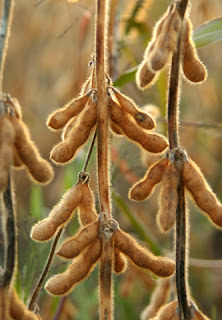AGRICULTURE | Soybean | The soybean (American) or soya bean (British) (Glycine max) is a species of legume native to East Asia, widely grown for its edible bean which has numerous uses. The soybean plant is an annual plant native to Southeast Asia. It has oblong pods that contain 2 to 4 seeds or beans. Soybeans are legumes, a member of the pea family, and are a source of high-quality protein. They are processed to make many foods and food additives.
The Soybean plant is classed as an oilseed rather than a pulse. Fat-free (defatted) soybean meal is a primary, low-cost, source of protein for animal feeds and most prepackaged meals; soy vegetable oil is another product of processing the soybean crop. For example, soybean products such as textured vegetable protein (TVP) are ingredients in many meat and dairy analogues. Soybeans produce significantly more protein per acre than most other uses of land.
Traditional nonfermented food uses of soybeans include soy milk, and from the latter tofu and tofu skin. Fermented foods include soy sauce, fermented bean paste, natto, and tempeh, among others. The Soybean oil is used in many industrial applications. The main producers of soy are the United States (35%), Brazil (27%), Argentina (19%), China (6%) and India (4%). The beans contain significant amounts of phytic acid, alpha-linolenic acid, and the isoflavones genistein and daidzein.
The soybean plant is sometimes referred to as greater bean . Both immature soybean and its dish are called edamame in Japan, but in English, edamame refers only to a specific dish.
The English word "soy" is derived from the Japanese pronunciation of shōyu, the Japanese word for soya sauce; "soya" comes from the Dutch adaptation of the same word.
The genus name of soybean, Glycine was originally introduced by Carl Linnaeus (1737) in his first edition of Genera Plantarum. The word glycine is derived from the Greek - glykys (sweet) and likely refers to the sweetness of the pear-shaped (apios in Greek) edible tubers produced by the native North American twining or climbing herbaceous legume, Glycine apios, now known as Apios americana. The cultivated soybean first appeared in Species Plantarum, by Linnaeus, under the name Phaseolus max L. The combination Glycine max (L.) Merr., as proposed by Merrill in 1917, has become the valid name for this useful plant.
The genus Glycine Willd. is divided into two subgenera, Glycine and Soja. The subgenus Soja (Moench) F.J. Herm. includes the cultivated soybean, Glycine max (L.) Merr., and the wild soybean, Glycine soja Sieb. & Zucc. Both species are annuals. Glycine soja is the wild ancestor of Glycine max, and grows wild in China, Japan, Korea, Taiwan and Russia. The subgenus Glycine consists of at least 16 wild perennial species: for example, Glycine canescens F.J. Herm. and G. tomentella Hayata, both found in Australia and Papua New Guinea.
Like some other crops of long domestication, the relationship of the modern soybean to wild-growing species can no longer be traced with any degree of certainty. It is a cultural variety with a very large number of cultivars.
Soybean varies in growth and habit. The height of the plant varies from below 20 cm (7.9 in) up to 2 metres (6.6 ft).
The pods, stems, and leaves are covered with fine brown or gray hairs. The leaves are trifoliolate, having three to four leaflets per leaf, and the leaflets are 6–15 cm (2.4–5.9 in) long and 2–7 cm (0.79–2.8 in) broad. The leaves fall before the seeds are mature. The inconspicuous, self-fertile flowers are borne in the axil of the leaf and are white, pink or purple.
The fruit is a hairy pod that grows in clusters of three to five, each pod is 3–8 cm long (1–3 in) and usually contains two to four (rarely more) seeds 5–11 mm in diameter.
Soybeans occur in various sizes, and in many hull or seed coat colors, including black, brown, blue, yellow, green and mottled. The hull of the mature bean is hard, water resistant, and protects the cotyledon and hypocotyl (or "germ") from damage. If the seed coat is cracked, the seed will not germinate. The scar, visible on the seed coat, is called the hilum (colors include black, brown, buff, gray and yellow) and at one end of the hilum is the micropyle, or small opening in the seed coat which can allow the absorption of water for sprouting.
Remarkably, seeds such as soy beans contain high levels of proteins undergo desiccation, and yet survive and revive after water absorption. A. Carl Leopold, son of Aldo Leopold, began studying this capability at the Boyce Thompson Institute for Plant Research at Cornell University in the mid-1980s. He found soybeans and corn for a range of soluble carbohydrates protecting the seed cell viability. Patent has been assigned to the early 1990s on techniques for protecting "biological membranes" and proteins in the dry state. Compare to tardigrades. - AGRICULTURE
Soybean
Tags: soybean etf, soybean etfs, soybean oil etf, trading soybean futures, soybean futures contract, soybean trading, soybean options, soybean oil cholesterol, soybean oil trading, soybean crusher, soybean foam insulation, soybean insulation, soybean premiums, soybean peptide, cme soybean oil, soybean quote, soybean crushing, soybean herbicides, soybean formula, soybean crushers, soybean growth









No comments:
Post a Comment